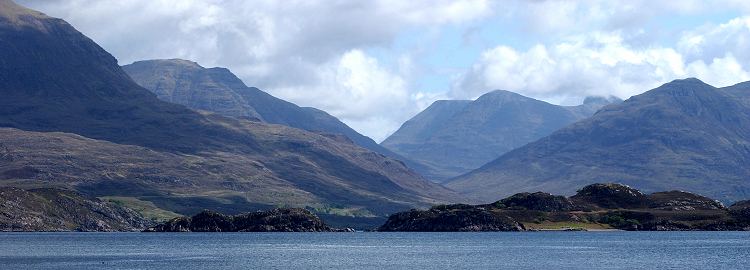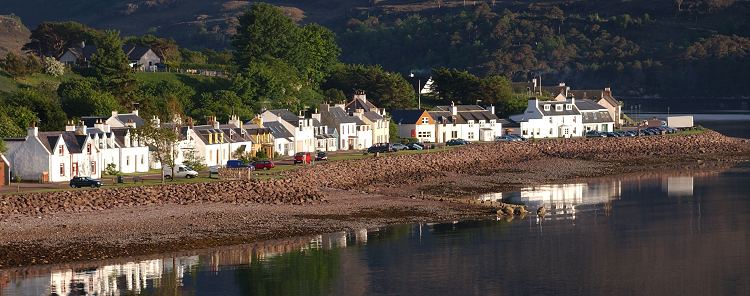
This page is available in Gaelic ~ link here 
Torridon
& Shieldaig – an historical perspective

Torridon
Torridon can be seen as the gateway to the Torridonian Highlands and the ancient rocks of that unusually
geologically twisted landscape. The red sandstone of Torridon is is one of the oldest
rocks in the world, having been laid down over 2500 million years
ago. In some places, it is capped by a hard, white quartzite.
There
are records that show that Queen Victoria loved to travel
the road between Torridon and Diabaig in the late
nineteenth century. Accompanied by John Brown, amongst others,
she described this area as a fine and wild uncivilised
spot, like the end of the world, as she wrote in her diary,
and she noted that “hardly anyone ever comes here”.
Sadly,
the area was victim to some particularly heartless clearances
in these glens, especially when the estate was sold in 1831
to Colonel McBarnet who had made
his wealth exploiting plantation workers in the West Indies. The tenant farmers were immediately cleared
off to allow sheep farming,
and were only left with a tiny amount of land
to grow potatoes. McBarnet ruled that that no tenant could keep any sheep or
cattle, and the only cow was kept at the Inn. Eventually, in 1859, all the inhabitants of the area were resettled
at Annat, at the head of the loch,
on land taken from the already pitifully small holdings of
the people there, land that was already exhausted and liable
to flooding. Meanwhile, the inhabitants of Alligin, a previously prosperous village were ordered by McBarnet to give up their sheep. Crofters were only allowed
to keep one cow - and its calf for six months. After that,
they were deprived of a quarter of their arable land which
was given to incoming shepherds.
The
estate was later sold to Duncan Darroch,
a wealthy man from Gourock, near Glasgow. Fortune changed again – this time, for
the better. Darroch wanted a deer
forest, not a sheep farm, and he saw no conflict between crofters
and the presence of deer. He also believed that sheep ruined
the mountain grazings for deer and
cattle. So he cleared off the sheep, restored the lower grazings to the crofters and allowed their cattle to share
the hill grazings with the deer.
He gave land to the previously evicted tenants at Torridon.
He also fenced off the crofting land so that deer could not
eat the growing crops. He allocated peat bogs for the old
and new villages, and gave positive encouragement (instead
of forbidding) the collection of seaweed for fertilizer. He
lent the tenants money for the purpose of buying cattle or
for building boats.
Duncan
Darroch died at Torridon House in
1910. On a stone by the roadside just beyond Torridon,
his widow placed the words:
“In memory of the devotion and affection shown by one hundred men
on the estate of Torridon, who,
at their request, carried his body from the house here on
its way to interment in the family burial place at Gourock.”
Soon
after buying the estate,
Darroch had sold off the Ben Damh
section to the Earl of Lovelace. So when Torridon
was bought after his death by Lord Woolavington,
it was only the north side of the loch that was involved.
His actual name was James Buchanan whose fortune had been
made in the Black and White whisky company. He did not visit
Torridon very much, and sold it
to Sir Charles Blair Gordon of Montreal. He died in 1939 and eight years later the
estate was sold to Richard Gunter from Yorkshire, who moved live in Torridon.
When he died in 1960, the Earl of Lovelace then bought tTorridon to add to the Ben Damh
property that one of his predecessorshad acquired when Duncan Darroch
separated it from the northern part of the estate. After Ben
Damh House was converted into a hotel, the Lovelaces came to live at Torridon
House; when the fourth Earl died in 1964, Torridon
was accepted by the Inland Revenue in part payment of death
duty, and was transferred three years later to the National
Trust for Scotland. The hotel is currently run by Dan & Rohaise Rose
Bristow.

Shieldaig
Shieldaig is situated at the head of Loch Shieldaig which is itself an inlet of Loch Torridon, which stretches north-westwards out towards open
sea, flanked by the Torridonian Mountains on its north-east side, and the hills of
North Applecross on the other.
Shieldaig was not originally built by the dispossessed
crofters from the nearby glens, as were most coastal villages.
It was constructed in Napoleanic
times (around 1800) specifically to provide and train sailors
for the Royal Navy. This was the idea of the Duke of Argyle
who was a member of the Board of Admiralty. The site was considered
to be a good position for a village. There were already some
local cattle farmers living there, living on long leases from
Mackenzie of Applecross. At first, no one could be found to build the village,
and it was not until 1810 that the construction began.
The
government gave generous grants for boat-building, guaranteed
prices for fish supplies, adequate quantities of duty-free
salt, plenty of land for all tenants, and a new road to connect
Shieldaig with Kishorn and Lochcarron. The people
who came to live in Shieldaig did
well. They were able to build large boats in order to fish
in the outer waters, and the salt allowed them to cure their
fish catches at low cost before being sent southwards to markets.
By
the time that the new village was fully functioning, the threat
that Napoleon had posed had slipped away; there is no record
of how many sailors from Shieldaig
joined the Royal Navy.
Shieldaig was considered to be one of the finest villages
on the west coast at this time, but sadly, things were to
change. The Mackenzies of Applecross sold their
large estates to the Duke of Leeds. His wife was one of the
family who had been responsible for the cruel Sutherland clearances.
She allowed her gamekeeper to prioritise
sheep-farmers over mariners and sailors. He instigated new
rules whereby cattle-grazing was taken away from the smaller
tenants and added to sheep farms that were rented out to the
innkeeper and a local merchant. The fishermen and crofters
became poor. When the Duke of Leeds broke up the Applecross
property into smaller sections, the Lochcarron
estate, including the village of Shieldaig was sold to Sir John Stewart. His sons went
deerstalking in Glenshieldaig forest
and dispossessed many of the Shieldaig
tenants, taking over their houses for estate use. Most of
the land was rented out to incoming sheep farmers.
By
the 1860s, there only remained one offshore fishing boat remaining
– the inhabitants of Shieldaig were too poor to make any more although the fishing
remained good. The estate was criticized by the Royal Commission
for allowing cartloads of shingle from the shore of the loch
to be taken away for road-building and ballast. The villagers
were worried that their protection from storm tides was being
removed. By then the stone pier that had been built by the
Destitution Board during the potato famine in the 1840s was
still standing, but lack of maintenance by the estate had
allowed it to crumble away significantly.
The
Lochcarron estate was eventually sold to the Murrays, and Shieldaig
fared much better.
Until
the early 1960s the road from Lochcarron
stopped at Shieldaig. Then a road was built to link with the Glen Torridon road, with a bridge to 'bridge the Balgy Gap'. This shortened the journey from Shieldaig to Torridon to 6 miles (from 68 miles), and also meant that the route was opened up Achnasheen, Gairloch and the north.